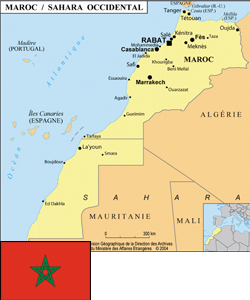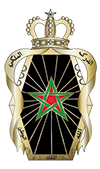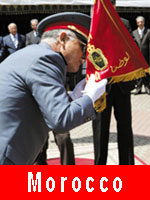
Royal Moroccan Gendarmerie

|
1957 Attachment authority: Administration of National Defense Workforce: 33 000 General manager: Général de corps d’armée Address: État-major de la gendarmerie royale Tél.: 00.212.537.27.99.60 Fax: 00 212.537.68.08.24 Cooperation manager: Général de brigade Mohammed BOUSSEBAA Tél.: 00.212.537.27.99.60 Email: screc@menara.ma Website: www.gendarmerie-royale.com.sitew.com/ 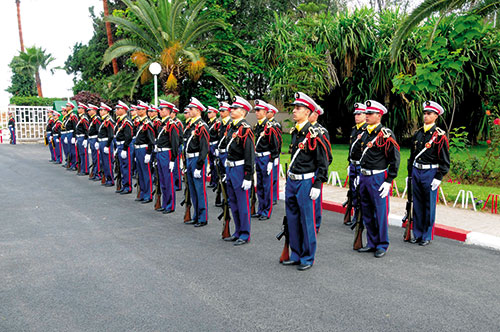
|
History
Before the independence, the French Gendarmerie is represented within the expeditionary columns (or expeditionary forces) sent in western Morocco in 1907. During the French protectorate (1912-1956), the Forces of law and order, become a corps of gendarmes from January 1928, expand its network of brigades through the kingdom. At the time of the independence, strong of 1 500 personnels, the Morocco French Gendarmerie strengths consists of a general staff under a General command, of a legion with 5 companies, 15 sections and 103 brigades, and of the 12th mobile corps of gendarmes with 9 squadrons. Created by the statutory order (Dahir) of April 29th, 1957, the Moroccan Royal Gendarmerie takes over from the French Gendarmerie that offers it its assistance until 1960, definitive dissolution date of the Gendarmerie technical support frame, of the anti-riot mobile Gendarmerie and the Morocco Provost Gendarmerie detachment. The Dahir of January 14th, 1958 fixes the principle of action of its service. Between 1991 and 2000, the Moroccan Royal Gendarmerie staff passes from 12 000 personnels, among whom 240 officers, to 20 000 personnels among whom 700 officers. On October 20th, 1999, it joins the FIEP.
Organization
Central Organization
The Moroccan Royal Gendarmerie’s (MRG) Commander has a General Staff composed of the organs of command and control, management, technical support and logistic support for all the components of the institution, namely:
• the territorial Gendarmerie;
• the anti-riot police;
• the Air Gendarmerie;
• the Gendarmerie maritime coastguard;
• the provost Gendarmerie;
• the specialized units.
Territorial organization
The territorial Gendarmerie (TG)
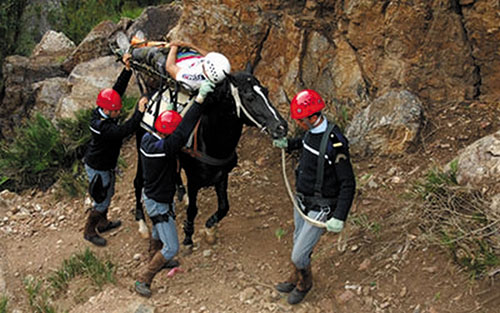
The TG is the major element of the MRG of which it ensures almost all of the missions that are confided to it by the law. It is the TG that covers the territory and which is in narrow and permanent contact with the citizens. The TG is spread over the whole Morocco. It comes in 3 hierarchical levels adapted to the kingdom administrative apportionment: regions, companies and brigades. The territorial brigades (TB), the MRG real kingpins, are implanted according to a territorial meshing ensuring a local service for the benefit of the citizens.
The territorial organization divides up in the following way:
• 28 territorial Gendarmerie region (no Squad of Gendarme level);
• 89 territorial Gendarmerie companies;
• 476 territorial Gendarmerie brigades.
The anti-riot police (Mobile Gendarmerie or Mob.G.)
The Mob.G is one MRG subdivision, which participates in the maintenance of law and order and which can, in case of necessity, bring a momentary reinforcement to the territorial units. It is organized in Squads of Mobile Gendarmes (SMG) and groups of "Platoon of gendarmes" or "mobile squadrons" (GPG or GMS).
The Gendarmerie Air Unit (GAU)
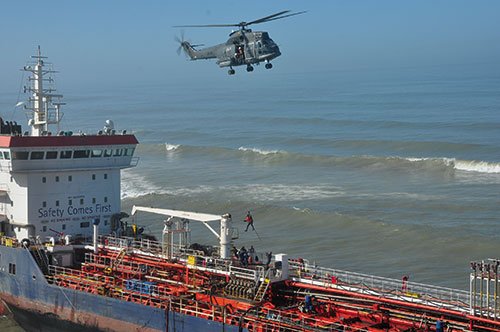
The GAU consist of groups endowed with helicopters and with light planes able to perform diversified missions requiring aircrafts intervention for transport, support, reconnaissance, rescue and others aerial missions.
The AG is constituted in particular of an air-sea group and two air groups.
The main missions provided by this unit are:
• the participation in the surveillance (coasts, maritime fishing zones, etc.);
• the participation in the fight against the natural plagues;
• the sea rescue with the other maritime units. This mission allows Morocco to meet its international commitments with regard to the sea rescue operations (SAR);
• the provisioning of the isolated or stricken zones;
• the participation in the sanitary evacuations.
The Gendarmerie of the Air (G.Air)
It consists of Air Brigades (AB), implanted in the military air bases, where it puts the Gendarmerie prerogatives in the service of these bases security.
The competences of these AB limit themselves:
• in the right-of-way area of those bases as well as in their immediate neighbourhoods and approaches (participation in the control and in the checks at the level of the accesses, in the installations security, the interface with the neighbourhood and the civil authorities);
• to the military or civil people subjected to the Air Force authority, as well as to their families.
The Gendarmerie of Air Transport (GAT)
It consists of units implanted in the civil airports.
These units participate:
• in the general security of airports and their immediate neighbourhoods and approaches;
• in the particular securing of the vital installations and the diverse movements and traffics inside the airports surrounding wall.
The Gendarmerie Maritime Coastguard ( G.Mar.C.)
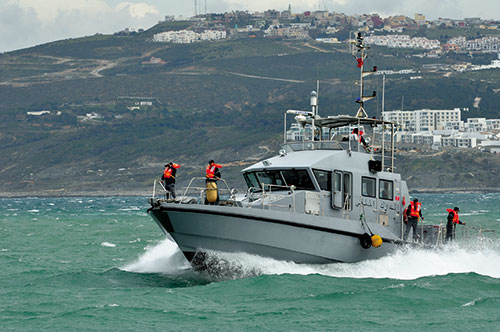
The G.Mar.C. consists of:
• Maritime brigades dedicated to the military naval bases security;
• Maritime brigades at the level of harbours, the activity of which constituting the continuation, on internal waters and along the coasts, of the traditional MRG G.Mar.C. mission on dry land.
The missions of these brigades consist mainly there in:
• the participation in the surveillance of the coast;
• the yachting control;
• the participation in the surveillance of the sea navigation;
• the participation in the halieutic resources conservation;
• the participation in the Search and Rescue missions, including by the scuba diving.
The Provost Gendarmerie (PG)
The PG is deployed beside:
• the Royal Armed forces units in operation;
• the contingents acting under the aegis of United Nations, outside the national territory.
It exercises, for their benefit, military police and military Criminal Investigation missions.
Specialized Training

• The Group of Squadrons of Honour (GSH).
• The Security and Intervention Group (SIG).
• The Cavalry Group (CG).
• Several specialized laboratories such as:
- the Royal Gendarmerie Criminalistics Institute (RGCI);
- the Royal Gendarmerie Laboratory of Genetics (RGLG);
- the Royal Gendarmerie Laboratory of the Acoustics (RGLA).
Missions
The law fixes the general mission of the MRG and defines its status:
• the Royal Gendarmerie is a force of law and order in charge of watching the public safety & security and ensuring the maintenance of law and order and the execution of the laws;
• the MRG is an integral part for the Royal Armed forces.
So, the MRG, "Home Army", is a public service, vested with a civil mission which extends itself with the concept of the law and order, and which comes essentially in the national territory coverage in order to ensure, there and through police actions, the law and order, the execution of the laws and the protection of the people, the properties and the institutions.
It is under the authority:
• administratively and fiscally of the Secretary in charge of the administration of the National defence;
• and for employment:
- of the minister of the interior for the general administrative police, the maintenance of law and order, the assistance and the rescue, etc.,
- of the Minister of Justice for the exercise of the Criminal Investigation Department.
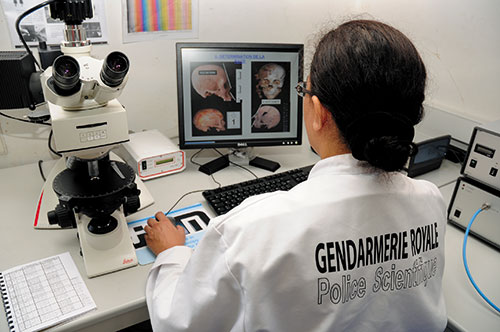
The law also imposes to it "to lend its help in order to assist the other ministerial departments" for the exercise of the administrative police special missions they are responsible for. It is the case for the departments:
• of the equipment, the transport and the logistics; for the road, railroad traffic, the port and airport facilities;
• of the agriculture and the sea fishing: for the fishing, the protection of the agricultural and halieutic resources;
• of Waters and forests; for the vegetation cover and fauna protection and the fight against the locust infestation threat;
• of the health: being generally the first one to arrive on the ground, the MRG may need to take the first aids then to assist the health services and the disaster and emergency services/civil defence.
So, beyond its missions relating to sovereignty, the MRG plays an important role in the support of the Morocco diverse strategies of development.
Territorial competence
Exercising mainly missions of administrative, judicial and military polices, the MRG is competent, de jure, on the whole national territory.
In fact, it shares territorially this competence with the "National Security" (Moroccan police), which is competent in the urban perimeters. So, the MRG ensures the security in rural areas and outlying suburbs, what represents more than 90% of the territory, 48,98% of the population, more than 95% of the communication routes, 3 200 km of coast and borders.
Staff
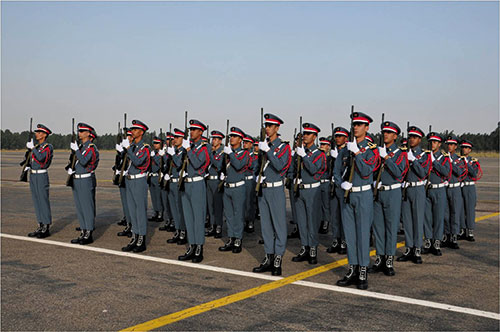
The MRG staff consists of officers (approximately 2 000) and non-commissioned officers (31 000), including 3% women. Staff is distributed according to the needs required for the completion of the range of tasks that each of its subdivisions is able to fulfill. Thus, the territorial Police employs 51% of staff; 10% in favor of the mobile, 17% for Central Services and 22% in specialized units.
The officers arise:
• from military inter-service academies or from the internal promotion.
After their arrival as officers in the MRG, they are attending internships training courses of application to be capable of serving in this institution.
The non-commissioned officers arise directly from the royal School of the Royal Gendarmerie and its "annexes". They follow, afterward:
• an in-service training for the update of the knowledge and the capacities;
• trainings for specializations necessary for the institution interest.
The exercise of the Criminal Investigation Department requires a qualification of official empowered to make arrests, granted to the gendarmes by a joint decision of the supervisory ministry and that of the Justice, after an appropriate course and training.
Training institutions
• For officers at different levels: Royal School of Police Officers (Erog) in Casablanca.
• For NCOs:
- basic training: Royal School of Gendarmerie (ERG), distributed between Marrakech and Benguérir Benslimane,
- Specific training (forensics, new technologies, road safety, law enforcement, etc.) centers dedicated to these courses at different sites of the GRM.
Main equipment
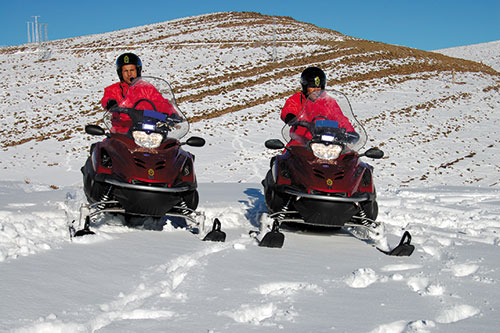
• Armament: pistols (HK VP70, Heckler and Koch HK4, Walther PPK, Beretta 92, MAB PA-15, PIMP model 1950, SIG Sauer P226, Sig Sauer P228, Colt Special Detective, Smith and Wesson Model 10, HK MK23), submachine guns (HK USP, SMG Heckler and Koch MP5, P90, Uzi FN, MAT-49, Ingram MAC-10, HK UMP), assault rifles (SAR 21, M16, M4 rifle, FN FAL, HK G36), rifles of precision (FR F1, Ratio PGM Ultima, M24), Combat Rifles (Benelli M4, SPAS-12, SPAS-15, PM-5 Valtro).
• Vehicles: jeep, Toyota Prado, motorcycles (BMW 1200 RT).
• Air power/aerials means: helicopters: SA.342 Gazelle, AS.350 Ecureuil, SA.315B Lama, SA.330 Puma, AS332 Super Puma, SA.316 Alouette III, SA.365 Dauphin II, Sikorsky S-70 Black Hawk, EC 145 and EC 135. Planes: planes for fighting against the fires (Ayres Turbo Trush, ULM Tornado), planes for Search and rescue missions (BN-2T Islander).
• Nautical means: coastal speedboats for the gendarmerie maritime coastguard.
Cooperation
Since its creation, the MRG did not stop developing channels of cooperation:
• internally with the country security organs;
• internationally with the foreign similar institutions:
- in bilateral and in multilateral within the framework of the past agreements,
- within the FIEP, (association of the euro Mediterranean Gendarmerie and Police strengths with military status) since 1999.
With the appearance of new forms of criminality and the diversification of the threat, the MRG tendency is for the intensification and for the improvement of its exchanges within the framework of the cooperation.
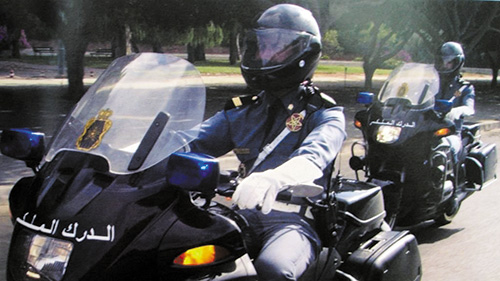
Evolution and perspectives
The MRG develops centres of excellence in several domains:
• the strengthening of the scientific competence and skills by:
- the control of the new information technologies and the communications in order to:
. strengthen and secure the connection and data processing means,
. fight against the cybercrime,
- the control in forensic sciences in order to improve the efficiency while protecting the ethics, in the fight against organized criminality,
• the strengthening of the coordination and the cohesion between the various MRG subdivisions and the continuity of the action thanks to the air and maritime vectors;
• the strengthening of the environmental protection.
For decades, the MRG develops within it capacities dedicated to the environmental protection, within the framework of its administrative police missions, in particular those concerning:
• the protection of the people and the properties (quality of the consumable products, the conservation of the resources, etc.);
• the public healthiness and the aesthetics (diverse pollutions, in particular waters and air, grounds and vegetation cover degradation).
It has deployed, for that purpose, regional Environment Brigades (EB) having for mission:
• to raise territorial brigades awareness in the detection of pollutants and risks of pollution;
• to take under their responsibility the proved pollutions in order to put an end to them, at the need by provoking the intervention of the concerned departments.
The MRG current size (33 000 servicemen) is not definitive. It is in full evolution under the influence of the profound transformations and the reforms that the country knows since a few years:
• a general fund of consolidation of the State subject to the rule of law, according to the 1st July, 2011 Constitution and to the legislation which ensues from it;
• the advanced regionalization, with a regional council elected in the universal suffrage, which entails the GRM territorial reorganization in order to adapt itself to the new administrative apportionment, accompany the reforms by an adapted and well-adjusted devolution, and to ensure a better local police.
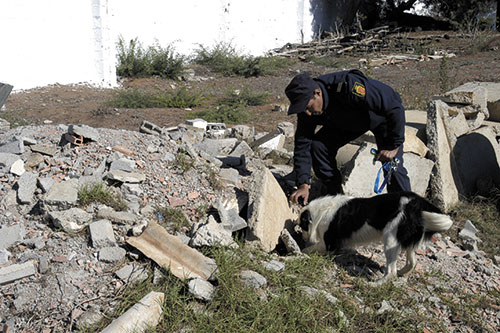
© The iconography was provided by the concerned gendarmeries

